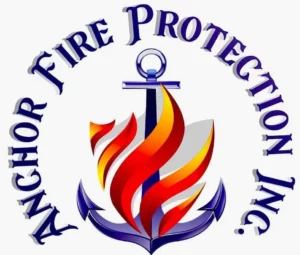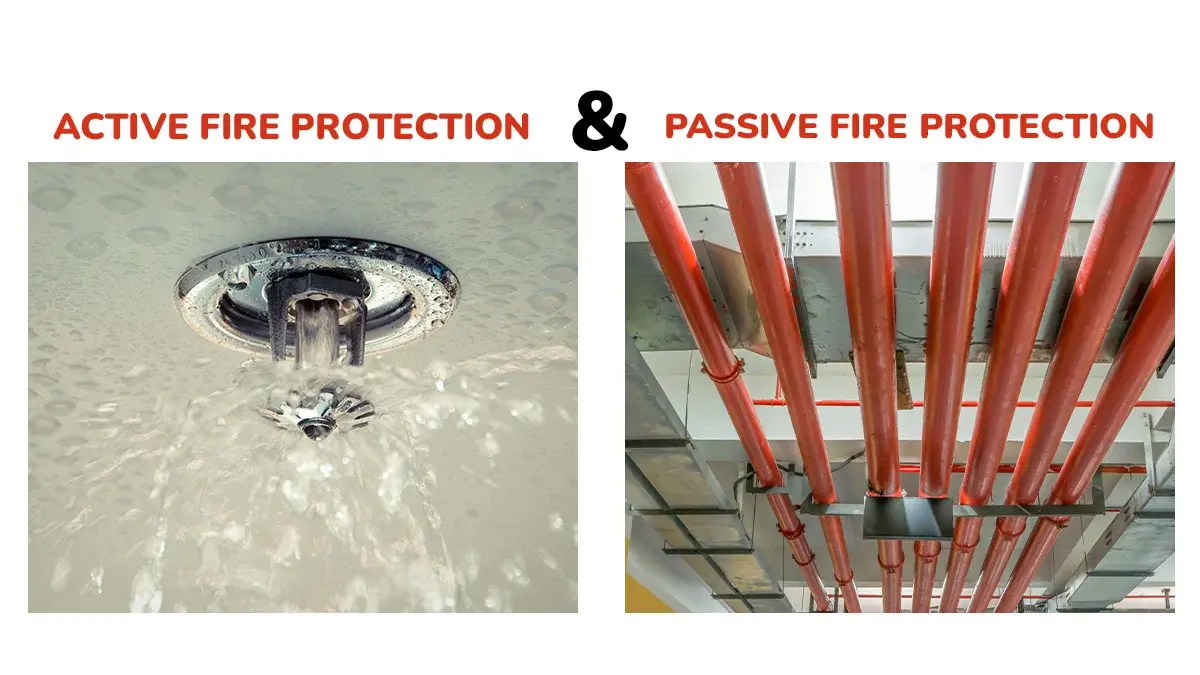What is active and passive fire protection? Complete guide.
Over time, we have realized how crucial proper fire protection is in every building. While many people only think of fire sprinklers and extinguishers, these are just a small part of the necessary measures. Many crucial fire protection aspects often go unnoticed within a building. Safety in your home or workplace is paramount, and fire safety shouldn’t be taken lightly. Fires can be incredibly destructive, so protecting ourselves and our belongings is crucial. This is not just common sense; it is also the law for businesses and landlords to implement appropriate fire safety measures. If you are looking for fire protection services for your business, you might have encountered the terms active fire protection and passive fire protection. These terms are used to differentiate between different types of fire safety systems. We’ll explore what these terms mean in the next section.
This article will outline the primary differences between active and passive fire protection as well as provide you with an overview of the many fire safety services that Anchor Fire Protection Inc. provides. Our company offers a wide range of fire safety services to clients searching for both active and passive fire prevention solutions in the Los Angeles area.
UNDERGROUND FIRE PROTECTION SERVICES IN LOS ANGELES
Out of the various underground fire protection services in Los Angeles, like fire proofing, fire suppression systems, and fire alarm and detection systems, there are two types of fire protection services that we will be discussing. Active fire protection (AFP). It is about detecting, stopping, and escaping fire. Passive fire protection (PFP) is about containing the fire and preventing it from spreading further. You need both an active and passive fire safety system working together to prevent, detect, alert, restrict, and potentially suppress a developing fire.
Active Fire Protection System
In the case of a fire, the active fire protection system category of fire safety systems requires motion or activity before the system will operate. A traditional fire extinguisher can be used manually for this task, or an automatic fire detection and suppression system can be used. Active fire protection initiates a response in response to an alert or other indicator. The activity alone will contain, suppress, or put out a fire that has already started. Although the most visible forms of active fire protection are fire suppression systems, fire detection and alarm systems are equally important and fall under this category as well.
These systems are designed to identify signals and then trigger a proper response, such as activating a system, closing fire doors, or contacting the fire department. Keep your fire alarm and suppression systems working, and you can significantly improve your chances of suppressing or even totally putting out a fire before it does harm.
Active fire safety is all about taking action to stop or warn about a fire. Think of it as the alarm system and firefighters working together. It can be something you do yourself, like using a fire extinguisher, or something automatic, like sprinklers or alarms.
Fire Protection Helpers in the Active Fire Protection Process
- Fire alarms: These loud sirens go off when they sense smoke or heat, letting you know to get out safely.
- Emergency lights: These bright lights turn on when the power goes out, helping you see and escape during a fire.
- Fire sprinklers: These are water sprayers on the ceiling that automatically turn on to put out flames.
- Smoke vents: These are special openings in the building that let smoke out, making it easier to see and breathe during an escape.
- Fire extinguishers: These are portable devices filled with water, foam, or powder to put out small fires.
- Refuge areas: These are safe spaces where people needing assistance can wait for firefighters to help them evacuate.
- Fire hydrants and hoses: These are water sources and long pipes firefighters use to fight large fires.
- Communication systems: These allow firefighters to talk to each other and to the building occupants during an emergency.
Consider it important to learn how to use a fire extinguisher properly. You need to make sure to check and maintain your smoke alarms and fire extinguishers regularly. When you have an escape plan in case of a fire, it helps save precious lives and properties.
Passive Fire Protection
The passive fire protection market is expected to reach an estimated value of $31 billion by 2026, as per Global Market Insights. PFP, or passive fire protection, is similar to a system of internal barriers in a structure. These obstacles help keep a fire contained and stop it from spreading. Consider it similar to using fire-resistant flooring, doors, and walls to divide a building into rooms. Although fire doors function normally, they are designed to withstand fire for a longer period of time, giving people more time to flee.
PFP plays a crucial role in several ways:
- Safety: During a fire, it gives individuals more time to flee, which helps keep them safe.
- Protection of the building: It reduces damage to the structure and its fixtures, including furniture and equipment.
- Business continuity: PFP helps firms recover from fire incidents more quickly by minimizing damage.
Although PFP does not require continuous care, it should be regularly inspected and maintained to make sure it functions properly. This might be compared to testing smoke detectors; although they are always “on,” they still require routine testing in order to ensure proper operation when needed. Passive fire control, in general, is an essential component of any building’s fire safety plan and is critical to the protection of people and property.
Fire Protection Helpers in the Passive Fire Protection Process
There are several helpers that are considered passive fire protection that can be incorporated into your fire strategy.
- Fire doors: A fire door, like the gate to a section of the maze, slows the spread of smoke and fire to other rooms, allowing more time for everyone to safely escape.
- Walls, floors, and ceilings: These fire-resistant materials, similar to thicker maze walls, prevent the spread of fire from one room to another.
- Fire curtains: These resemble unique doors that automatically drop in order to block the flow of the fire in specific locations. They are a good option in some situations because they are reasonably priced.
- Air vent: Hidden air vent aids are called fire and smoke filters. They automatically close in the case of a fire to stop smoke and flames from spreading to nearby rooms through the vents.
Fire blocking service penetrations are essential for effective passive fire protection, mainly because they are frequently located in concealed places, where they may remain undetected until a fire breaks out in the absence of a complete fire risk assessment.
Why do you need both fire protection systems?
Although they serve fundamentally different purposes, both active and passive fire protection are equally significant to the building’s security in general. A fire is extinguished with the use of active fire protection. One way to stop a fire from spreading or from starting is to use passive fire protection. In order for people to safely leave and/or attempt to put out the fire, they cooperate by warning people within the building of the fire and keeping it under control. When combined, active and passive fire protection provide complete fire protection in a full safety strategy. Being aware of the distinctions between AFP and PFP can help you feel more secure, knowing that your valuables are safeguarded.
For expert advice on safeguarding the unique threats enclosed in your buildings, get in contact with Anchor Fire Protection Inc. right now.
Conclusion
In order to protect the people of your building and the residents, you must implement both active and passive fire prevention measures. What you need to make sure of is that the installation and maintenance of fire safety systems in your homes and buildings must be done properly, by qualified professionals, and on a regular basis. The highly qualified and experienced fire safety consulting team members at Anchor Fire Protection Inc. can help with any aspect of fire safety at your facility.
KEEP YOUR PROPERTY SAFE
Related posts
-
Fire Safety Tips for the Workplace
-
Fire Safety Tips for Hospitals
-
How to size fire pumps?
-
Different types of sprinklers?
-
What is fire protection system?
-
Fire Extinguisher Inspection
-
Fire Sprinkler System Components
-
What are the most common types of fire pumps?
-
How much does a fire sprinkler system cost?
-
What is active and passive fire protection?

